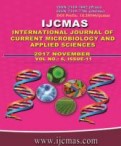


 National Academy of Agricultural Sciences (NAAS)
National Academy of Agricultural Sciences (NAAS)

|
PRINT ISSN : 2319-7692
Online ISSN : 2319-7706 Issues : 12 per year Publisher : Excellent Publishers Email : editorijcmas@gmail.com / submit@ijcmas.com Editor-in-chief: Dr.M.Prakash Index Copernicus ICV 2018: 95.39 NAAS RATING 2020: 5.38 |
Although yeast cells are often present as benign commensal organisms of healthy individuals, specially Candida has become emerge pathogen in last few decades due to various factors like AIDS and increased number of patients receiving immunocompromised drugs during organ transplantation and cancer therapy. Along with rise of incidence of candida infection, the emergence of drug resistance further worsens the situation. So we have studied the prevalence of candida species from blood and urine sample. Out of total 167 samples, C. albicans were identified as 44 (26.3%) and remaining 123 (73.65%) were Non Albican Candida (NAC). Among Non Albican Candida (NAC), C. krusei was major isolate i.e.48 (28.7%) followed by C. tropicalis (14.9%) and other non-albicans Candida species. In our study about the susceptibility pattern of candida species to Amphotericine B, Fluconazole, Itraconazole, Voriconaole, Ketoconazole, Nystatin we have found that C. albicans was found resistant to Fluconazole, Ketoconazole in 22.7% and 13.6% cases respectively. For NAC, resistance to Fluconazole was found maximum in C. krusei 20 (41.6%) out of 48 isolates followed by C. parapsilosis 3 (13%) and C. tropicalis 3 (12%) out of 23 and 25 isolates respectively. No resistance was detected against Amphotericine B, Voriconazole, Nystatin and Itraconzole except C. tropicalis which is 2 (8%) out of 25 isolates against Itraconazole. On the other hand all C. glabrata isolates were sensitive to all antifungals.
 |
 |
 |
 |
 |